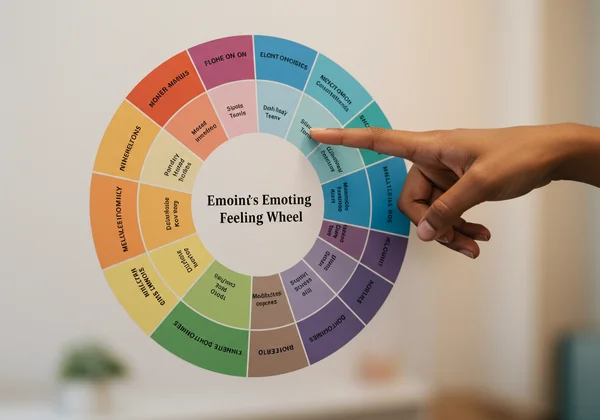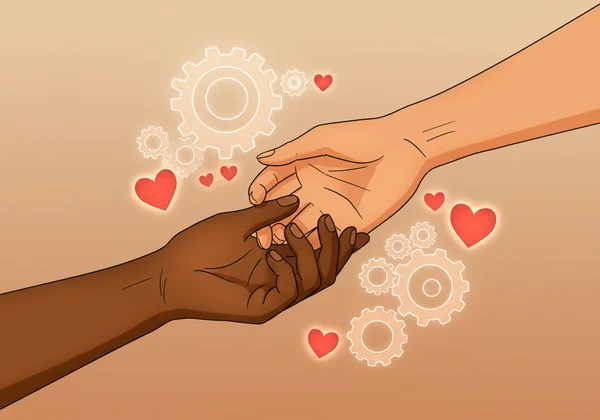Alexithymia Test in Relationships: Understanding Love & Communication
Are you or your partner struggling to understand or express emotions, leading to friction in your relationship? You're not alone. Many couples navigate the challenges of alexithymia in relationships—a difficulty identifying and describing feelings—without realizing there's a name for what they experience. Perhaps you're wondering, how do you tell if you have alexithymia? This guide offers practical strategies to bridge the emotional gap, foster deeper understanding, and build a more connected partnership, even when words feel elusive.
This journey inward, towards understanding, is where true connection begins. By exploring these dynamics, you can begin to transform confusion into connection. If you're curious about your own emotional profile, you can [discover your emotional patterns] on our homepage.
Understanding Alexithymia's Impact on Your Relationship
Alexithymia is not a lack of feeling; it's a disconnect in processing and verbalizing those feelings. Research published by the National Institutes of Health highlights its prevalence and impact on various aspects of life, including relationships. In a relationship, this can create misunderstandings that feel like deep chasms. One partner may feel unloved or ignored, while the other feels confused and pressured, unable to provide the emotional language their partner seeks. Recognizing the signs is the first step toward empathy and finding new ways to connect.

What Does Alexithymia Look Like in a Partnership?
In practice, alexithymia can manifest in subtle but significant ways. A partner with high alexithymic traits might:
- Struggle to say "I love you" or express affection verbally.
- Respond to an emotional crisis with practical, solution-focused advice instead of comfort.
- Appear distant or indifferent during arguments because they can't articulate their inner state.
- Have difficulty interpreting a partner's non-verbal cues, like tone of voice or facial expressions.
- Describe physical sensations (e.g., "my stomach hurts") rather than emotional states (e.g., "I feel anxious").
For someone like Jordan, a self-explorer who feels "clumsy" with emotions, these situations are common. Their partner might ask, "What are you feeling?" and the honest answer, "I don't know," can be frustrating for both people involved.
The Emotional Disconnect: How Alexithymia Affects Intimacy
Intimacy is built on shared vulnerability and emotional resonance. When one person struggles to share their inner world, it can lead to a profound sense of loneliness for their partner. This emotional disconnect can be misinterpreted as a lack of care, desire, or love. The non-alexithymic partner may feel they are giving more emotionally than they receive, leading to resentment. Meanwhile, the partner with alexithymia may feel deeply connected but simply lacks the tools to show it in conventional ways, creating a painful gap between their intentions and their partner's perception. This is where learning to bridge that gap becomes essential for the health of the relationship.
Dating someone with alexithymia: Insights for Both Sides
Navigating a relationship with alexithymia requires a dual approach—one of self-discovery for the individual with alexithymic traits and one of profound empathy for their partner. Success lies in both individuals committing to understanding and adapting. It's not about "fixing" someone, but about building a new, shared language of connection.
If You Have Alexithymia: Navigating Your Internal World Together
If you recognize yourself in the descriptions above, know that your experience is valid. It can be incredibly frustrating to feel something inside but be unable to name it. Start by giving yourself permission to explore your feelings without judgment.
-
Connect to Your Body: Instead of searching for an emotion word, describe the physical sensation. "My chest is tight" or "I feel heat in my face" are valid starting points that can help you and your partner map your internal state.
-
Use Tools: An emotion wheel can be a fantastic aid for identifying and naming feelings. You can find various resources and tools, such as this emotion wheel guide from The Gottman Institute, to help expand your emotional vocabulary.
-
Be Honest: It's okay to say, "I'm feeling something strongly, but I need time to figure out what it is." This honesty is a form of emotional expression in itself.

Understanding your own patterns is a powerful act. An [alexithymia questionnaire] can provide a structured starting point for this self-exploration, offering insights that can be shared with your partner.
If Your Partner Has Alexithymia: Cultivating Empathy and Patience
Loving someone with alexithymia is a practice in expanding your definition of emotional expression.
- Focus on Actions: Your partner may show love through acts of service, loyalty, and dependability rather than words. Recognize and appreciate these forms of care.
- Ask Different Questions: Instead of "How do you feel?" try "What are your thoughts on this?" or "What part of that situation was most difficult?" This shifts the focus from an abstract emotional label to more concrete thoughts.
- Don't Personalize the Silence: Their difficulty with emotional language is about their internal wiring, not a reflection of their feelings for you. Remind yourself that their love is present, even if it's expressed differently.
Communicating with alexithymia: Bridging the Gap
Cultivating clear communication forms the bedrock of a thriving relationship. When alexithymia is present, couples must become more creative and intentional in how they share and connect. It involves moving beyond a reliance on words and embracing a broader spectrum of expression.
Beyond Words: Exploring Non-Verbal & Alternative Expression
Words are just one tool in the communication toolkit. Many people with alexithymia excel at non-verbal connection.
-
Shared Activities: Build intimacy through shared experiences. Cooking a meal, going for a hike, or working on a project together creates a bond through action, not discussion.
-
Physical Touch: For some, physical affection like holding hands, a hug, or sitting close together can communicate comfort and love more powerfully than any sentence.
-
Written Communication: Sometimes, the pressure of a face-to-face conversation is too much. Writing down thoughts and feelings in a letter, text, or shared journal can provide the space needed to articulate them without pressure.

Active Listening & Validation: Essential Tools for Partners
For the non-alexithymic partner, learning to listen differently is key. When your partner attempts to share, your role is to validate their effort, not to critique their delivery.
- Listen for the Attempt: Celebrate any effort to share, even if it's clumsy or incomplete.
- Validate, Don't Interrogate: Respond with phrases like, "Thank you for sharing that with me," or "It sounds like that was an intense experience." This shows you're on their team.
- Practice Patience: Allow for silence. Your partner may need extra time to process and find their words. Rushing them will only increase their frustration and cause them to shut down. Taking an [online alexithymia test] can be an insightful exercise to understand these communication styles better.
Alexithymia and love: Can True Connection Blossom?
This is often the most pressing question for couples. The answer is an emphatic yes. True connection and deep, meaningful alexithymia and love can absolutely flourish, but it often looks different from the cinematic ideal. It requires both partners to redefine what emotional connection means to them.
Redefining Emotional Expression in Love
Love in a relationship with alexithymia is often built on a foundation of unwavering loyalty, mutual respect, and profound acceptance. It’s a love demonstrated through consistent action and quiet presence. It's understanding that your partner being there to fix your flat tire is their way of saying "I care about your safety and well-being," which is a powerful expression of love.
Building Intimacy Through Shared Experiences & Understanding
Lasting intimacy is forged in the day-to-day moments of shared life. It's about knowing you have a partner who is fundamentally on your side, even if they can't always find the perfect words to comfort you. Building this type of intimacy comes from a deep, mutual understanding of each other's inner worlds. A great step towards this is compassionate curiosity. Exploring this together can start with a simple, private tool like an [alexithymia self-assessment].

Forging a stronger bond in the presence of alexithymia calls for patience, a deep well of understanding, and an open heart to discover novel ways of connecting. Remember, emotional intelligence is a skill that can be developed. By applying these strategies and seeking deeper insight, you can transform challenges into opportunities for growth and closer bonds.
Want to understand your emotional patterns better? [Take our free test] on our homepage to gain valuable insights. The tool is based on established psychological concepts like the OAQG2 and can be a fantastic starting point for conversation and growth. Please remember, this is an exploration tool and not a substitute for professional medical diagnosis.
Frequently Asked Questions About Alexithymia in Relationships
Can a marriage survive when one partner has alexithymia?
Absolutely. A marriage can not only survive but thrive when both partners are committed to understanding, empathy, and developing unique communication strategies. Success depends on the non-alexithymic partner learning to appreciate non-verbal expressions of love and the partner with alexithymia committing to self-exploration.
How do you tell someone they might have alexithymia without offending them?
Approach the conversation with curiosity and care, not accusation. Use "I" statements, such as, "I sometimes feel a disconnect when we talk about emotions, and I came across something called alexithymia that I found interesting. I wonder if it resonates with you at all?" Frame it as a shared journey of discovery.
Why do I struggle so much to communicate my feelings in my relationship?
While many factors can contribute to this, having high alexithymic traits is a significant one. It's a neurodevelopmental difference in how your brain processes and labels emotions. It's not a personal failing. Understanding this can be the first step toward finding new, more effective ways to connect with your partner and yourself.
Is alexithymia the same as being emotionally unavailable?
No, they are different. Alexithymia is a difficulty identifying and describing one's own emotions. A person with alexithymia can feel deeply but lacks the vocabulary to express it. Emotional unavailability is often a conscious or subconscious choice to avoid emotional intimacy, often as a defense mechanism. Gaining clarity on your own patterns can start with a tool like the [alexithymia test for adults].